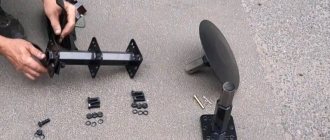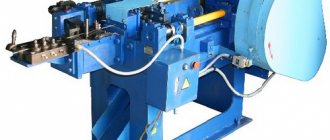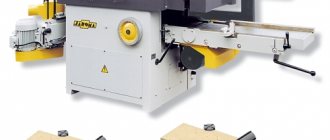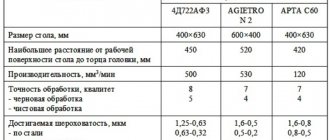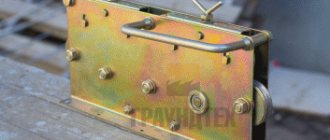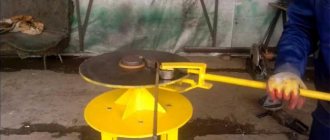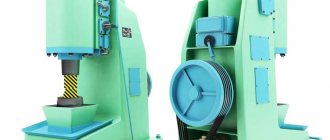One way to decorate areas is to use forged items. Fences, benches, gazebos, stair railings and other similar structures look very decorative. Moreover, in most cases, these products are not forging in its traditional sense. Most often, this is done not in a forge or with a hammer and anvil, but with the help of some devices that allow you to create a wide variety of patterns and products from metal strips and square rods. To make such products you will need cold forging machines. Some of them you can make with your own hands, others are easier to buy.
Fences, railings for stairs and balconies - you can also do it yourself
Canopy over the porch using cold forging
Porch railings are a decoration, not a purely utilitarian fixture.
You can make a gazebo and forged furniture
The gate looks magical
Machine "Snail"
Rolls steel rods into spirals, curls, rings, etc. The bending radius is limited only by the platform. It is a template for the production of serial products - cast, for individual work - with removable parts.
DIY device assembly diagram
General form
How to make curls on the “Snail”:
Types of forging equipment for cold forging
The technique of cold forging of metals made it possible to abandon the bulky forge, anvil and hammer.
The minimum set of forging equipment for cold forging of metal includes:
- Bending machines, or bending machines.
- Twisters.
- Wave.
- A snail.
- Flashlight.
In addition to specialized equipment for cold forging, you will need a workbench, a vice and a set of metalworking tools, and welding equipment is needed to connect some parts. An angle grinder will also come in handy.
Bends for cold forging
This is the simplest cold forging equipment available. It is designed to bend a strip or rod of metal at a certain angle. The simplest bending method is to bend the workpiece by hand while it is held in a vice. But this is only possible for rods and strips of small thickness; in addition, it is absolutely impossible to maintain both the angle and the bend radius.
If you need to bend rolled metal at a certain angle, and even in several places, use a plate with pins inserted into it - guides. To increase the force, horn extensions are used - or simply a piece of pipe placed on the free end of the workpiece. To increase accuracy and maintain the specified angle and bend radius, rollers are used - two fixedly mounted on the plate and one movable, sliding along a groove in the support plate. The pressing force on this roller is increased by a lever mechanism.
Bend for cold forging
If a hydraulic cylinder is attached to the movable roller, the work will become easier, the operating force of the installation and its accuracy will increase. In the case where a thin-walled pipe needs to be bent, a template of the required radius is used instead of a roller.
Features and advantages of twisters
Twisters, or torsion machines, are more complex forging equipment and are used for twisting rods along their longitudinal axis.
The operating principle of all twisters is the same - one end of the workpiece or group of them is clamped into a stationary mandrel, the other - into a movable one. The movable mandrel rotates around its axis, twisting the rods.
In the simplest version, the fixed mandrel is clamped in a vice, and the movable mandrel is driven by a hand crank. In this case, a strong pipe of slightly larger diameter is put on the workpieces to prevent unwanted longitudinal deformation of the rods.
There are options for forging equipment with mechanical worm gears and even with an electric drive, also through a gearbox.
A mandatory element of a mechanized twister is a strong frame connecting the mandrel supports. When twisting and deforming the metal, large longitudinal stresses arise, as a result of which it can become deformed. The robust frame allows it to withstand such deformations.
Twister for cold forging
When twisting the rods, their length decreases, so the movable support must be able to move along the frame.
The advantages of twisters are the ability to create:
- expressive shape and surface texture when twisting a single rod;
- unique decorations and details of interior items - lanterns (cones);
It is extremely difficult or simply impossible to create such shapes and textures using other metal processing methods.
This type of cold forging equipment is designed to bend curls from a strip or bar.
Lever volute
The simplest type of machine is a lever snail. A gripper for the beginning of the bending strip and a curl pattern, to which the strip is pulled with a horn lever gripper, are fixed on a massive platform.
Lever volute for cold forging
If you need to make many identical curls, then the template strip and grip are welded to a metal plate; if curls of different shapes and initial radii are required, use a wooden or plywood platform with a large number of holes into which hardened bolts are inserted to form the grip and template points. To perform such bending you need to have remarkable physical strength.
Snail with rotating plate
The template used is the same as in a lever volute, but a rotating platform is used, in which the end of the workpiece is fixed in the template, which is fed through a fixed stop-lock on the workbench.
Volute with rotary plate for cold forging
Rotating, the template draws the strip of metal into itself and bends it along the intended path. To facilitate labor when turning the plate, a worm drive is used.
Snail with collar and rotary share
There is an improved type of snail - a snail with a collar and a rotating blade. A collar is used to increase a person's physical strength. It rotates a crescent-shaped or spiral-shaped share made of especially strong steel. Folding shares are also used to produce parts of variable curvature and complex shapes.
Snail with collar and rotary share
Such a plowshare consists of several parts connected between axles and secured to each other with pin clamps. As one or another section of the complex spiral passes, the corresponding pin is removed and part of the ploughshare is folded without taking part in further cold forging. The workpiece is secured using a clamp on the platform. A roller moves in the groove, which presses the rod or strip to the ploughshare. When the gate is turned, according to the law of the lever, the ploughshare rotates along a smaller radius, but with proportionally greater force, the roller and presses the part against the clamps placed on the plate.
On a snail with a rotating blade, you can bend up to 5 turns of the spiral; thanks to the constant force, the products are the same, and due to the ability to adjust the roller pressure, you can get double curls and curls of variable curvature.
Summary like clockwork
Types of stamps and ready-made curls.
A good story is always easy to finish - the conclusions fall on their own, within the framework of logic and priorities.
In our review of cold forging technology, the harmonious conclusions are clear:
- Cold forging is a wonderful technology that allows you to combine what is impossible to combine in other processes:
- practical benefits on the farm;
- the possibility of artistic creativity;
- invention and application of own engineering discoveries;
- simplicity and reality of implementation for beginners;
- increasing self-esteem as a craftsman and as a resident of a house with elements of artistic forging.
- You can make devices for cold forging yourself and with high quality, it is better to start with snail and bending machines.
- It is more expedient to make manual equipment with a manual drive. The electric use case is too resource intensive. The only type of machine that is best made with an electric drive is a torsion bar one. The quality of twisting the rods will be much higher in this case.
- In the manufacture of forged products using the cold method, “help” from hot forging will not hurt. It is impossible to make a machine for tips and other small decorative elements on your own, but a purchased one costs a lot of money. Our advice is to make decorative details using hot forging. A small and neat forge in the household will not hurt. And it will contribute to professional growth: start with cold forging, come to real blacksmithing...
- You shouldn’t get stuck in the stereotypical “antique” painting of forged items. Modern colors and widespread eclecticism in design make possible the most unexpected color and texture solutions in metal work.
https://www.youtube.com/watch?v=bJWuvMMy1H0
Assembling the device
This version of the machine is used as an example because of its simplicity. Knowing the basic principles and sequence of equipment design, you can upgrade it at will. To assemble all parts of the equipment into a single whole, you will need to use:
- drill with carbide type drills;
- welding machine;
- a saw cutting metal or a hacksaw;
- metal sheet of the selected size;
- round metal pipe;
- metal rod;
- bearings of different sizes;
- bolts size M8.
To assemble a cold forging machine with your own hands, you need to use a proven sequence of actions:
- Initially, you need to assemble a stand that will serve as a support. To do this, all its components (pipe sections of the same size and the joints between them at the top and bottom edges) must be connected into a single whole. The design may resemble a stool in appearance. The connection is made using a welding machine, and the sections are cut with a saw.
- The next step is cutting the metal sheets. You should get circles of equal diameters and four triangles with equal sides. Triangular-shaped elements must be welded to the bottom of the connected pipe structure in such a way that something similar to a pyramid is formed. The base, which has a wider area, must be welded at the central point of the cut circle.
- Four strips that are located horizontally must be attached to a circle with an already welded element. This should be done using bolts; for this you will need a drill to make the holes.
- The next step is the construction of the handle. To do this you need to use two rods of different lengths. Their sizes can be determined by correlating them with the diameter of the circle. One rod should be commensurate with the diameter, the other should slightly exceed its size. When bending the first rod, you should maintain an angle of 30 degrees. Then weld both rods to each other, and then weld another rod into the lower part. There should also be a jumper between the first two sections, to which a lever is attached by welding, which should maintain the direction towards the structure made of rods.
- A bearing for future directional variability in the device must be attached to the end of the attached lever, as well as to the segment located at the bottom of the structure. The upper section serves as a mount for a metal coil, which must be installed horizontally - it makes it possible to bend the metal. On the lower side of the segment, where there is a free end, a hole should be made equal in diameter to the size of the pipe section.
- The last step in the algorithm of actions when constructing a machine for cold forging with your own hands will be the connection of the designed handle with a part of the device similar to a “pyramid”. These elements are fixed after putting on the handle with a wide-diameter nut, to which it is first necessary to weld a metal circle, which will allow the template itself to be attached to the machine. Next, the “snail” template is attached by welding.
Conclusion
Anyone who decides to take up forging seriously and make a cold forging machine with their own hands should be very scrupulous at the stage of creating drawings and calculations. Otherwise, the creation process is quite simple, and once you understand the principle of equipment design, you can come up with various variations of it that will help improve the product.
Equipment for wave and zigzag bending
Forging equipment for wave and zigzag bending resembles conventional pipe benders. Such equipment is equipped with additional rollers that form a wave or hold that part of the part that has already been bent.
Equipment for wave and zigzag bending
To accurately maintain the radius of the wave peaks, overlays with a corresponding bending radius and a depression corresponding to the diameter of the metal profile are used.
